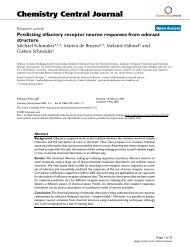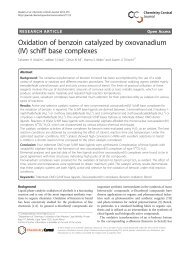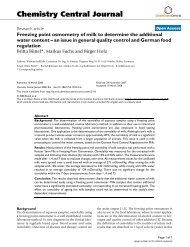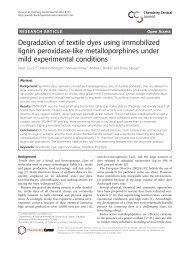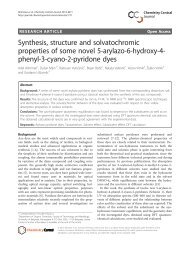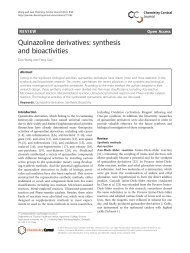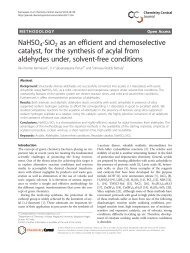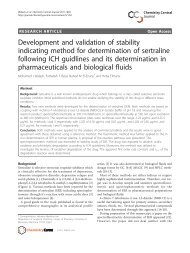Antioxidant activity relationship of phenolic compounds in ...
Antioxidant activity relationship of phenolic compounds in ...
Antioxidant activity relationship of phenolic compounds in ...
You also want an ePaper? Increase the reach of your titles
YUMPU automatically turns print PDFs into web optimized ePapers that Google loves.
Orčić et al. Chemistry Central Journal 2011, 5:34<br />
http://journal.chemistrycentral.com/content/5/1/34<br />
Page 4 <strong>of</strong> 8<br />
S<strong>in</strong>ce it is now recognized that there is no s<strong>in</strong>gle test<br />
to evaluate antioxidant activities <strong>of</strong> the <strong>compounds</strong> with<br />
wide spectra <strong>of</strong> structures, modes <strong>of</strong> action, and physical<br />
and chemical properties [23], several different assays<br />
were employed as a part <strong>of</strong> our <strong>in</strong>vestigation.<br />
DPPH (2,2-diphenyl-1-picrylhydrazyl) is a stable radical<br />
and is <strong>of</strong>ten used <strong>in</strong> assessment <strong>of</strong> the antioxidant<br />
<strong>activity</strong>. The free radical DPPH possesses a characteristic<br />
absorption at 517 nm (purple <strong>in</strong> color), which decreases<br />
significantly when exposed to radical-scavengers (due to<br />
hydrogen atoms transfer from antioxidant to DPPH). A<br />
lower absorbance at 517 nm <strong>in</strong>dicates a higher radicalscaveng<strong>in</strong>g<br />
<strong>activity</strong> <strong>of</strong> extract [24]. In this assay, the ability<br />
<strong>of</strong> the <strong>in</strong>vestigated H. perforatum fractions to act as<br />
donors <strong>of</strong> hydrogen atoms or electrons <strong>in</strong> transformation<br />
<strong>of</strong> DPPH radical <strong>in</strong>to its reduced form DPPH-H<br />
was <strong>in</strong>vestigated.<br />
The <strong>activity</strong> observed is <strong>in</strong> a very good correlation<br />
with the composition, where the most active fractions<br />
are those rich <strong>in</strong> flavonoid glycosides (followed by m<strong>in</strong>ute<br />
amounts <strong>of</strong> <strong>phenolic</strong> acids) and poor <strong>in</strong> biflavonoids<br />
(ament<strong>of</strong>lavone,biapigen<strong>in</strong>):I/2,II/2pandII/2s.As<br />
opposed to this, fractions with high biflavonoids level<br />
and low flavonoid glycosides content (I/3, I/5) exhibited<br />
significantly lower <strong>activity</strong> (i.e. higher IC 50 values), and<br />
fraction I-4, practically devoid <strong>of</strong> flavonoids and <strong>phenolic</strong><br />
acids, was the least active. It is notable that only flavonoid<br />
glycosides (with quercet<strong>in</strong>-3-O-rut<strong>in</strong>oside,<br />
galactoside and rhamnoside as the most abundant) seem<br />
to contribute significantly to radical-scaveng<strong>in</strong>g <strong>activity</strong><br />
(given as 1/IC 50 ), with Pearson’s correlation coefficient r<br />
= 0.778 (0.922 if the outlier - II/2p - is excluded),<br />
together with <strong>phenolic</strong> acids (r = 0.769, or 0.929 without<br />
II/2p). These observations are only partially <strong>in</strong> agreement<br />
with the previous results [21]. While it would be<br />
expected for flavonoid aglycones to be more active than<br />
their 3-O-glycosides [23], no correlation was found<br />
between aglycones content and antioxidant <strong>activity</strong> as<br />
determ<strong>in</strong>ed by DPPH test, and the <strong>activity</strong> <strong>of</strong> fractions<br />
I/3 and I/5 (rich <strong>in</strong> flavonoid and biflavonoid aglycones,<br />
poor <strong>in</strong> glycosides and <strong>phenolic</strong> acids) is low.<br />
At the same time, no correlation was found between<br />
<strong>activity</strong> and content <strong>of</strong> naphthodianthrones and phlorogluc<strong>in</strong>ols,<br />
which is <strong>in</strong> accordance with the results <strong>of</strong><br />
Silva et al. [23]. The low <strong>activity</strong> <strong>of</strong> biflavonoids present<br />
<strong>in</strong> Hypericum perforatum extracts was already documented<br />
[22] and is to be expected. These <strong>compounds</strong>, be<strong>in</strong>g<br />
dimers <strong>of</strong> apigen<strong>in</strong>, possess only 4’-hydroxyl on B-r<strong>in</strong>g,<br />
while it is known that for maximum <strong>activity</strong> a catechol<br />
structure (3’,4’-dihydroxylated benzene moiety), as present<br />
<strong>in</strong> quercet<strong>in</strong>, is required [21-23,25].<br />
FRAP test is based on nonspecific reduction <strong>of</strong> Fe 3<br />
+ -TPTZ <strong>in</strong>to the blue Fe 2+ -TPTZ by the extract, which<br />
leads to an <strong>in</strong>creased absorbance at 593 nm. Results are<br />
presented as mg <strong>of</strong> Fe 2+ /1 g <strong>of</strong> dried fraction and represent<br />
the mass <strong>of</strong> Fe 3+ that can be reduced by 1 g <strong>of</strong> H.<br />
perforatum fraction. Several important facts should be<br />
kept <strong>in</strong> m<strong>in</strong>d when <strong>in</strong>terpret<strong>in</strong>g results <strong>of</strong> the test. First,<br />
it measures ability <strong>of</strong> a sample to participate <strong>in</strong> one-electron<br />
redox reactions, mean<strong>in</strong>g that antioxidants with different<br />
mode <strong>of</strong> action (e.g. carotenoids, behav<strong>in</strong>g as<br />
radical scavengers) will not be ignored. Second, only<br />
water-soluble antioxidants will react s<strong>in</strong>ce the assay is<br />
performed <strong>in</strong> aqueous solution. Third, the reduction<br />
capacity determ<strong>in</strong>ed <strong>in</strong> the absence <strong>of</strong> biomolecules as<br />
substrates does not necessarily reflect the antioxidant<br />
<strong>activity</strong> i.e. protective capabilities. Still, it can be a relevant<br />
factor <strong>in</strong> detoxification <strong>of</strong> reactive species such as<br />
HOCl and ONOO - [26].<br />
FRAP test has shown that H. perforatum fractions<br />
have the significant reduction potential, with fractions I/<br />
1, I/2 and II/2p be<strong>in</strong>g more active than the synthetic<br />
antioxidant BHT. Tak<strong>in</strong>g <strong>in</strong>to account the results <strong>of</strong><br />
HPLC analysis, reduction capacity may be attributed<br />
mostly to the content <strong>of</strong> <strong>phenolic</strong> acids and flavonoid<br />
glycosides (although Pearson’s correlation coefficients<br />
are quite low, 0.768 and 0.584, respectively). The contribution<br />
<strong>of</strong> phlorogluc<strong>in</strong>ols to the total reduction capacity<br />
is negligible - two fractions rich <strong>in</strong> these <strong>compounds</strong>, I/<br />
4 and I/3, exhibited the lowest capacity <strong>of</strong> all the samples<br />
exam<strong>in</strong>ed. Their <strong>in</strong><strong>activity</strong> can be expla<strong>in</strong>ed by the<br />
lack <strong>of</strong> easily oxidizable functional groups (such as <strong>phenolic</strong><br />
moiety). The low <strong>activity</strong> is also observed for<br />
naphthodianthrones and biflavonoids, fractions with<br />
especially high content <strong>of</strong> these <strong>compounds</strong> (I/3, II/3, I/<br />
4, I/5) hav<strong>in</strong>g the lowest reduction capacity.<br />
In superoxide anion test the ability <strong>of</strong> H. perforatum<br />
fractions to neutralize superoxide anion radical (O 2 - )<br />
was evaluated. While superoxide is <strong>in</strong>tentionally producedbysomecells(phagocytes)<br />
<strong>in</strong> order to combat<br />
<strong>in</strong>fection, its presence is usually deleterious to organism,<br />
lead<strong>in</strong>g (if not degraded by superoxide dismutase) to<br />
degenerative processes and death. In the employed<br />
assay, O 2 - anion was generated <strong>in</strong> situ, by electrontransfer<br />
from NADH to O 2 present <strong>in</strong> solution (a process<br />
analogous to NADPH oxidase- and NADH dehydrogenase-catalyzed<br />
generation <strong>in</strong> vivo) [20].<br />
All <strong>in</strong>vestigated extract fractions exhibited dosedependent<br />
O 2 - scaveng<strong>in</strong>g <strong>activity</strong>. The weakest <strong>activity</strong><br />
was aga<strong>in</strong> observed <strong>in</strong> samples rich <strong>in</strong> biflavonoids,<br />
naphthodianthrones and phlorogluc<strong>in</strong>ols but with low<br />
levels <strong>of</strong> other <strong>phenolic</strong>s - I/4 and I/5. A high degree <strong>of</strong><br />
correlation was found between the <strong>activity</strong> (expressed as<br />
1/IC 50 ) and the content <strong>of</strong> <strong>phenolic</strong> acids (r = 0.857),<br />
flavonoid aglycones (r = 0.791, without the outlier I/5: r<br />
= 0.926), and sum <strong>of</strong> <strong>phenolic</strong> acids, flavonoid aglycones<br />
and glycosides (r = 0.883, or 0.921 without fraction I/5).<br />
These observations are <strong>in</strong> agreement with the empirical





